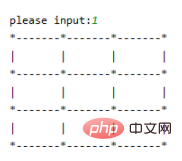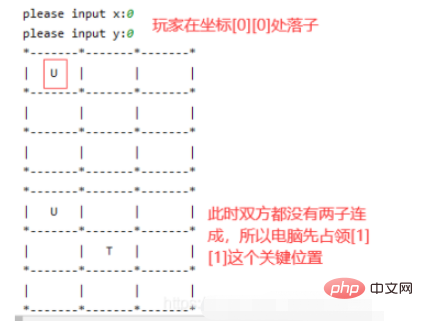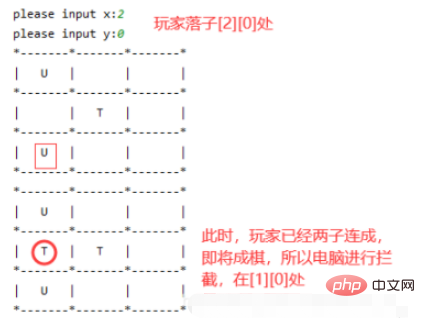How to implement three-piece chess game in python
1. Basic process
The implementation logic of the three-piece chess game is as follows:
1. Create an initialized 3*3 chessboard;
2. The player holds the U piece and moves the piece first;
3. Determination of victory or defeat [win, loss, draw], if the outcome is not decided, continue as follows
4. The computer holds the T piece and makes a move;
5. Determination of victory or defeat, if the victory is If the result is negative, continue from step 2
2. Basic steps
1. Menu interface
Select 1 to start the game, and select 2 to exit the game
def menu():
print('-'*20)
print('1---------------begin')
print('2---------------exit')
print('please select begin or exit')
print('-' * 20)
while(1):
select = input('please input:')
if select == '1':
begin_games()
pass
elif select == '2':
print('exit the game')
break
#pass
pass2. Initialize the chessboard and print the chessboard
The three-piece chess board is a 3*3 square matrix and is stored in a list in python.
chess_board = [[0, 0, 0], [0, 0, 0], [0, 0, 0]]
So how to print out this storage list and turn it into a chessboard?
def init_cheaa_board(chess_board): #先对列表进行初始化
for i in range(MAX_ROW):
for j in range(MAX_COL):
chess_board[i][j] = ' '
pass
def print_chess_board(chess_board): #棋盘打印
print('*'+'-'*7+'*'+'-'*7+'*'+'-'*7+'*')
for i in range(MAX_ROW):
print('|'+' '*3+chess_board[i][0]+' '*3+'|'+' '*3+chess_board[i][1]+' '*3+'|'+' '*3+chess_board[i][2]+' '*3+'|')
print('*' + '-' * 7 + '*' + '-' * 7 + '*' + '-' * 7 + '*')
pass
pass
3. Player’s move
The player selects the horizontal and vertical coordinates of the move on the 3*3 chessboard. The coordinate point needs to meet the following requirements: 1. The point is within the chessboard; 2. The point has not yet been placed.
def player_first(chess_board):
while(1):
x = int(input('please input x:'))
y = int(input('please input y:'))
if(chess_board[x][y] != ' '): #若已被置子,则重新选择坐标
print('This position is already occupied!')
pass
elif(x >= MAX_ROW or y >= MAX_COL or x < 0 or y < 0): #所选坐标超出棋盘范围,重新选择坐标
print('This position is beyond the chessboard!')
pass
else: #若坐标可以落子,则将该坐标置为玩家的棋子U
chess_board[x][y] = 'U'
print_chess_board(chess_board)
#return x,y
break
pass
pass4. Computer placement
Computer placement algorithm:
4.1. First check the chessboard to see if there are two consecutive pieces on the chessboard occupied by the computer. The state of chess. If it already exists, get the coordinate point that can promote victory and make a move T;
4.2. If 4.1 is not satisfied, check the chessboard again to see if there are already two pieces in a row on the board that the player has occupied. The state of becoming or about to become a chess piece. If it already exists, get the coordinate point where the player is about to win, and move the T to intercept;
4.3. If 4.1 and 4.2 are not satisfied, select a favorable point on the computer side to make the move;
A. First determine whether the central position [1][1] is occupied. If not, this is the most advantageous point. When the [1][1] point is occupied, the player's four horizontal, vertical, diagonal, and sub-diagonal lines are blocked;
B, the secondary advantageous points are the four on the 3*3 chessboard Corner, each corner occupied will block the player's three routes;
C. The last advantageous point is the center of each side, which will block the player's two routes;
def Intercept_player(chess_board,key):
count2 = 0
index2 = []
intercept_index = {'x':-1,'y':-1}
for i in range(MAX_ROW):
index = []
count = 0
count1 = 0
index1 = []
allindex = [0,1,2]
for j in range(MAX_ROW):
if(chess_board[i][j] == key): #每一行的玩家落子情况
count += 1
index.append(j)
if(chess_board[j][i] == key): #每一列的玩家落子情况
#print('j'+str(j)+',i'+str(i)+'='+chess_board[j][i])
count1 += 1
index1.append(j)
if (i == j and chess_board[j][i] == key): # 在主对角线中的玩家落子情况
count2 += 1
index2.append(j)
if(count == 2): #在每一行中 获取具体的可以拦截的位置坐标 需要排除掉已经填充的位置
result = list(set(allindex).difference(set(index)))
result = result[0]
if(chess_board[i][result] == ' '): #当这个位置可以进行拦截时,进行坐标返回
#return i,result
intercept_index['x'] = i
intercept_index['y'] = result
return intercept_index
#print(count1,'------->',index1)
if (count1 == 2): # 在每一列中 获取具体的可以拦截的位置坐标 需要排除掉已经填充的位置
result = list(set(allindex).difference(set(index1)))
result = result[0]
#print('count1==2,result:',result)
if (chess_board[result][i] == ' '): # 当这个位置可以进行拦截时,进行坐标返回
intercept_index['x'] = result
intercept_index['y'] = i
return intercept_index
#return i, result
if (count2 == 2): # 在主对角线上 获取具体的可以拦截的位置坐标 需要排除掉已经填充的位置
result = list(set(allindex).difference(set(index2)))
result = result[0]
if (chess_board[i][result] == ' '): # 当这个位置可以进行拦截时,进行坐标返回
intercept_index['x'] = i
intercept_index['y'] = result
return intercept_index
#return i, result
count3 = 0
if(chess_board[0][2] == key):
count3 += 1
if (chess_board[1][1] == key):
count3 += 1
if (chess_board[2][0] == key):
count3 += 1
if(count3 == 2):
if(chess_board[0][2] == ' '):
intercept_index['x'] = 0
intercept_index['y'] = 2
elif (chess_board[1][1] == ' '):
intercept_index['x'] = 1
intercept_index['y'] = 1
elif (chess_board[2][0] == ' '):
intercept_index['x'] = 2
intercept_index['y'] = 0
return intercept_index
def computer_second(chess_board): #电脑智能出棋
#1、先检查一下电脑是否两子成棋 若已有,则获取空位置坐标 自己先成棋
intercept_index = Intercept_player(chess_board, 'T')
if (intercept_index['x'] == -1 and intercept_index['y'] == -1):
pass
else: # 电脑可落子
x = intercept_index['x']
y = intercept_index['y']
chess_board[x][y] = 'T'
return
#2、若玩家快成棋 则先进行拦截
intercept_index = Intercept_player(chess_board,'U') #若玩家已经两子成棋 则获取空位置的坐标
#print('intercept_index---:')
#print(intercept_index)
if(intercept_index['x'] == -1 and intercept_index['y'] == -1):
pass
else: #电脑可落子
x = intercept_index['x']
y = intercept_index['y']
chess_board[x][y] = 'T'
return
#3、如果没有,则电脑端排棋 以促进成棋
#3.1、 占领中心位置 如若中心位置[1,1]未被占领
if(chess_board[1][1] == ' '):
chess_board[1][1] = 'T'
return
#3.2、 占领四角位置 若[0,0] [0,2] [2,0] [2,2]未被占领
if (chess_board[0][0] == ' '):
chess_board[0][0] = 'T'
return
if (chess_board[0][2] == ' '):
chess_board[0][2] = 'T'
return
if (chess_board[2][0] == ' '):
chess_board[2][0] = 'T'
return
if (chess_board[2][2] == ' '):
chess_board[2][2] = 'T'
return
# 3.3、 占领每一边中心位置 若[0,1] [1,0] [1,2] [2,1]未被占领
if (chess_board[0][1] == ' '):
chess_board[0][1] = 'T'
return
if (chess_board[1][0] == ' '):
chess_board[1][0] = 'T'
return
if (chess_board[1][2] == ' '):
chess_board[1][2] = 'T'
return
if (chess_board[2][1] == ' '):
chess_board[2][1] = 'T'
return5. Win or Lose Determination
Final result: Lose, win, draw D
Determination process: Determine whether player U or computer T connects three pieces on each horizontal line, vertical line, and diagonal line , if so, that side wins; when the entire chess surface is occupied but neither the player nor the computer succeeds, it means a draw.
def chess_board_isfull(chess_board): #判断棋盘是否填充满
for i in range(MAX_ROW):
if (' ' in chess_board[i]):
return 0
return 1
pass
def Win_or_lose(chess_board):
isfull = chess_board_isfull(chess_board)
for i in range(MAX_ROW): #每一列的判断
if( chess_board[0][i] == chess_board[1][i] == chess_board[2][i]):
return chess_board[0][i]
pass
pass
for i in range(MAX_ROW): # 每一行的判断
if( chess_board[i][0] == chess_board[i][1] == chess_board[i][2]):
return chess_board[i][0]
pass
pass
if (chess_board[0][0] == chess_board[1][1] == chess_board[2][2]): # 判断棋盘正对角线
return chess_board[0][0]
if (chess_board[0][2] == chess_board[1][1] == chess_board[2][0]): # 判断棋盘反对角线
return chess_board[0][2]
if isfull:
return 'D' # 经过以上的判断,都不满足(既没赢也没输),但是棋盘也已经填充满,则说明和棋
else:
return ' '3. Overall code
# coding=utf-8import random
MAX_ROW = 3
MAX_COL = 3
#array = ['0','0','0']
chess_board = [[0, 0, 0], [0, 0, 0], [0, 0, 0]] #[array] * 3
def init_cheaa_board(chess_board):
for i in range(MAX_ROW):
for j in range(MAX_COL):
chess_board[i][j] = ' '
pass
def print_chess_board(chess_board):
print('*'+'-'*7+'*'+'-'*7+'*'+'-'*7+'*')
for i in range(MAX_ROW):
print('|'+' '*3+chess_board[i][0]+' '*3+'|'+' '*3+chess_board[i][1]+' '*3+'|'+' '*3+chess_board[i][2]+' '*3+'|')
print('*' + '-' * 7 + '*' + '-' * 7 + '*' + '-' * 7 + '*')
pass
pass
def player_first(chess_board):
while(1):
x = int(input('please input x:'))
y = int(input('please input y:'))
if(chess_board[x][y] != ' '):
print('This position is already occupied!')
pass
elif(x >= MAX_ROW or y >= MAX_COL or x < 0 or y < 0):
print('This position is beyond the chessboard!')
pass
else:
chess_board[x][y] = 'U'
print_chess_board(chess_board)
#return x,y
break
pass
pass
def chess_board_isfull(chess_board): #判断棋盘是否填充满
for i in range(MAX_ROW):
if (' ' in chess_board[i]):
return 0
return 1
pass
def Win_or_lose(chess_board):
isfull = chess_board_isfull(chess_board)
for i in range(MAX_ROW): #每一列的判断
if( chess_board[0][i] == chess_board[1][i] == chess_board[2][i]):
return chess_board[0][i]
pass
pass
for i in range(MAX_ROW): # 每一行的判断
if( chess_board[i][0] == chess_board[i][1] == chess_board[i][2]):
return chess_board[i][0]
pass
pass
if (chess_board[0][0] == chess_board[1][1] == chess_board[2][2]): # 判断棋盘正对角线
return chess_board[0][0]
if (chess_board[0][2] == chess_board[1][1] == chess_board[2][0]): # 判断棋盘反对角线
return chess_board[0][2]
if isfull:
return 'D' # 经过以上的判断,都不满足(既没赢也没输),但是棋盘也已经填充满,则说明和棋
else:
return ' '
def computer_second_random(chess_board): #电脑随机出棋
while(1):
x = random.randint(0,2)
y = random.randint(0,2)
if(chess_board[x][y] != ' '):
continue
else:
chess_board[x][y] = 'T'
break
def Intercept_player(chess_board,key):
count2 = 0
index2 = []
intercept_index = {'x':-1,'y':-1}
for i in range(MAX_ROW):
index = []
count = 0
count1 = 0
index1 = []
allindex = [0,1,2]
for j in range(MAX_ROW):
if(chess_board[i][j] == key): #每一行的玩家落子情况
count += 1
index.append(j)
if(chess_board[j][i] == key): #每一列的玩家落子情况
#print('j'+str(j)+',i'+str(i)+'='+chess_board[j][i])
count1 += 1
index1.append(j)
if (i == j and chess_board[j][i] == key): # 在主对角线中的玩家落子情况
count2 += 1
index2.append(j)
if(count == 2): #在每一行中 获取具体的可以拦截的位置坐标 需要排除掉已经填充的位置
result = list(set(allindex).difference(set(index)))
result = result[0]
if(chess_board[i][result] == ' '): #当这个位置可以进行拦截时,进行坐标返回
#return i,result
intercept_index['x'] = i
intercept_index['y'] = result
return intercept_index
#print(count1,'------->',index1)
if (count1 == 2): # 在每一列中 获取具体的可以拦截的位置坐标 需要排除掉已经填充的位置
result = list(set(allindex).difference(set(index1)))
result = result[0]
#print('count1==2,result:',result)
if (chess_board[result][i] == ' '): # 当这个位置可以进行拦截时,进行坐标返回
intercept_index['x'] = result
intercept_index['y'] = i
return intercept_index
#return i, result
if (count2 == 2): # 在主对角线上 获取具体的可以拦截的位置坐标 需要排除掉已经填充的位置
result = list(set(allindex).difference(set(index2)))
result = result[0]
if (chess_board[i][result] == ' '): # 当这个位置可以进行拦截时,进行坐标返回
intercept_index['x'] = i
intercept_index['y'] = result
return intercept_index
#return i, result
count3 = 0
if(chess_board[0][2] == key):
count3 += 1
if (chess_board[1][1] == key):
count3 += 1
if (chess_board[2][0] == key):
count3 += 1
if(count3 == 2):
if(chess_board[0][2] == ' '):
intercept_index['x'] = 0
intercept_index['y'] = 2
elif (chess_board[1][1] == ' '):
intercept_index['x'] = 1
intercept_index['y'] = 1
elif (chess_board[2][0] == ' '):
intercept_index['x'] = 2
intercept_index['y'] = 0
return intercept_index
def computer_second(chess_board): #电脑智能出棋
#1、先检查一下电脑是否两子成棋 若已有,则获取空位置坐标 自己先成棋
intercept_index = Intercept_player(chess_board, 'T')
if (intercept_index['x'] == -1 and intercept_index['y'] == -1):
pass
else: # 电脑可落子
x = intercept_index['x']
y = intercept_index['y']
chess_board[x][y] = 'T'
return
#2、若玩家快成棋 则先进行拦截
intercept_index = Intercept_player(chess_board,'U') #若玩家已经两子成棋 则获取空位置的坐标
#print('intercept_index---:')
#print(intercept_index)
if(intercept_index['x'] == -1 and intercept_index['y'] == -1):
pass
else: #电脑可落子
x = intercept_index['x']
y = intercept_index['y']
chess_board[x][y] = 'T'
return
#3、如果没有,则电脑端排棋 以促进成棋
#3.1、 占领中心位置 如若中心位置[1,1]未被占领
if(chess_board[1][1] == ' '):
chess_board[1][1] = 'T'
return
#3.2、 占领四角位置 若[0,0] [0,2] [2,0] [2,2]未被占领
if (chess_board[0][0] == ' '):
chess_board[0][0] = 'T'
return
if (chess_board[0][2] == ' '):
chess_board[0][2] = 'T'
return
if (chess_board[2][0] == ' '):
chess_board[2][0] = 'T'
return
if (chess_board[2][2] == ' '):
chess_board[2][2] = 'T'
return
# 3.3、 占领每一边中心位置 若[0,1] [1,0] [1,2] [2,1]未被占领
if (chess_board[0][1] == ' '):
chess_board[0][1] = 'T'
return
if (chess_board[1][0] == ' '):
chess_board[1][0] = 'T'
return
if (chess_board[1][2] == ' '):
chess_board[1][2] = 'T'
return
if (chess_board[2][1] == ' '):
chess_board[2][1] = 'T'
return
def begin_games():
global chess_board
init_cheaa_board(chess_board)
result = ' '
while(1):
print_chess_board(chess_board)
player_first(chess_board)
result = Win_or_lose(chess_board)
if(result != ' '):
break
else: #棋盘还没满,该电脑出棋
#computer_second_random(chess_board)
computer_second(chess_board)
result = Win_or_lose(chess_board)
if (result != ' '):
break
print_chess_board(chess_board)
if (result == 'U'):
print('Congratulations on your victory!')
elif (result == 'T'):
print('Unfortunately, you failed to beat the computer.')
elif (result == 'D'):
print('The two sides broke even.')
def menu():
print('-'*20)
print('1---------------begin')
print('2---------------exit')
print('please select begin or exit')
print('-' * 20)
while(1):
select = input('please input:')
if select == '1':
begin_games()
pass
elif select == '2':
print('exit the game')
break
#pass
pass
if __name__ == "__main__":
menu()
pass4. Result display
4.1 The following screenshot shows the process of computer interception, occupying a favorable position, and taking the lead in making a move



The above is the detailed content of How to implement three-piece chess game in python. For more information, please follow other related articles on the PHP Chinese website!

Hot AI Tools

Undresser.AI Undress
AI-powered app for creating realistic nude photos

AI Clothes Remover
Online AI tool for removing clothes from photos.

Undress AI Tool
Undress images for free

Clothoff.io
AI clothes remover

AI Hentai Generator
Generate AI Hentai for free.

Hot Article

Hot Tools

Notepad++7.3.1
Easy-to-use and free code editor

SublimeText3 Chinese version
Chinese version, very easy to use

Zend Studio 13.0.1
Powerful PHP integrated development environment

Dreamweaver CS6
Visual web development tools

SublimeText3 Mac version
God-level code editing software (SublimeText3)

Hot Topics
 1377
1377
 52
52
 Do mysql need to pay
Apr 08, 2025 pm 05:36 PM
Do mysql need to pay
Apr 08, 2025 pm 05:36 PM
MySQL has a free community version and a paid enterprise version. The community version can be used and modified for free, but the support is limited and is suitable for applications with low stability requirements and strong technical capabilities. The Enterprise Edition provides comprehensive commercial support for applications that require a stable, reliable, high-performance database and willing to pay for support. Factors considered when choosing a version include application criticality, budgeting, and technical skills. There is no perfect option, only the most suitable option, and you need to choose carefully according to the specific situation.
 HadiDB: A lightweight, horizontally scalable database in Python
Apr 08, 2025 pm 06:12 PM
HadiDB: A lightweight, horizontally scalable database in Python
Apr 08, 2025 pm 06:12 PM
HadiDB: A lightweight, high-level scalable Python database HadiDB (hadidb) is a lightweight database written in Python, with a high level of scalability. Install HadiDB using pip installation: pipinstallhadidb User Management Create user: createuser() method to create a new user. The authentication() method authenticates the user's identity. fromhadidb.operationimportuseruser_obj=user("admin","admin")user_obj.
 Navicat's method to view MongoDB database password
Apr 08, 2025 pm 09:39 PM
Navicat's method to view MongoDB database password
Apr 08, 2025 pm 09:39 PM
It is impossible to view MongoDB password directly through Navicat because it is stored as hash values. How to retrieve lost passwords: 1. Reset passwords; 2. Check configuration files (may contain hash values); 3. Check codes (may hardcode passwords).
 Does mysql need the internet
Apr 08, 2025 pm 02:18 PM
Does mysql need the internet
Apr 08, 2025 pm 02:18 PM
MySQL can run without network connections for basic data storage and management. However, network connection is required for interaction with other systems, remote access, or using advanced features such as replication and clustering. Additionally, security measures (such as firewalls), performance optimization (choose the right network connection), and data backup are critical to connecting to the Internet.
 How to solve mysql cannot connect to local host
Apr 08, 2025 pm 02:24 PM
How to solve mysql cannot connect to local host
Apr 08, 2025 pm 02:24 PM
The MySQL connection may be due to the following reasons: MySQL service is not started, the firewall intercepts the connection, the port number is incorrect, the user name or password is incorrect, the listening address in my.cnf is improperly configured, etc. The troubleshooting steps include: 1. Check whether the MySQL service is running; 2. Adjust the firewall settings to allow MySQL to listen to port 3306; 3. Confirm that the port number is consistent with the actual port number; 4. Check whether the user name and password are correct; 5. Make sure the bind-address settings in my.cnf are correct.
 Can mysql workbench connect to mariadb
Apr 08, 2025 pm 02:33 PM
Can mysql workbench connect to mariadb
Apr 08, 2025 pm 02:33 PM
MySQL Workbench can connect to MariaDB, provided that the configuration is correct. First select "MariaDB" as the connector type. In the connection configuration, set HOST, PORT, USER, PASSWORD, and DATABASE correctly. When testing the connection, check that the MariaDB service is started, whether the username and password are correct, whether the port number is correct, whether the firewall allows connections, and whether the database exists. In advanced usage, use connection pooling technology to optimize performance. Common errors include insufficient permissions, network connection problems, etc. When debugging errors, carefully analyze error information and use debugging tools. Optimizing network configuration can improve performance
 How to optimize MySQL performance for high-load applications?
Apr 08, 2025 pm 06:03 PM
How to optimize MySQL performance for high-load applications?
Apr 08, 2025 pm 06:03 PM
MySQL database performance optimization guide In resource-intensive applications, MySQL database plays a crucial role and is responsible for managing massive transactions. However, as the scale of application expands, database performance bottlenecks often become a constraint. This article will explore a series of effective MySQL performance optimization strategies to ensure that your application remains efficient and responsive under high loads. We will combine actual cases to explain in-depth key technologies such as indexing, query optimization, database design and caching. 1. Database architecture design and optimized database architecture is the cornerstone of MySQL performance optimization. Here are some core principles: Selecting the right data type and selecting the smallest data type that meets the needs can not only save storage space, but also improve data processing speed.
 How to use AWS Glue crawler with Amazon Athena
Apr 09, 2025 pm 03:09 PM
How to use AWS Glue crawler with Amazon Athena
Apr 09, 2025 pm 03:09 PM
As a data professional, you need to process large amounts of data from various sources. This can pose challenges to data management and analysis. Fortunately, two AWS services can help: AWS Glue and Amazon Athena.




